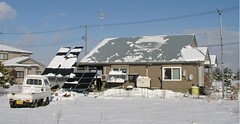 Image by richardmasoner via Flickr
Image by richardmasoner via Flickr
In the present world, people are aware of the many benefits of wind power systems, and the way in which they can cut down on electricity costs by using these devices. However, there exists one practical problem - how does one acquire an efficient wind power system at a relatively cheap price?
People can opt to buy ready-made wind power-plants from the market. However, these systems are rather expensive, and cost around $4000 on average. Even if the system functions properly, and reduces electricity bills by generating power, paying back such a large initial investment would take several years. Thus, wind power systems that are made at home find greater favor among many individuals, primarily due to their low costs (around $100 to $200).
However, before actually installing a homemade wind power system, two factors need to be considered. Firstly, strong wind currents (at a minimum of 8 mph) must be available at home. Also, any local by-laws that bar people from installing these systems in the area need to be taken into account. In case there are no such laws, and strong wind currents are available, homemade wind power systems can be installed. The process of installing such wind turbines is as follows:
There are five chief components of any homemade wind power system. These components are, a power generator, an electronic controller, a tower for installation of the units, blades that would turn the shaft of the generator, and a portable mount with a tail, that would keep the wind power system facing in the right direction.
The generator required in a homemade power system has to be a well-functioning DC motor, with a relatively low rpm count. These generators are easily available, either on the web (at eBay), or at hardware stores nearby. As is well known, when the DC motors are turned in the opposite direction, they function as electric generators. Homemade systems generally require Ametek DC motors, with 325 rpm and 30 volt power.
The blades that are used to turn the shafts need to be procured next. 4 inch PVC pipes (which are 24 inches long) can be used to make these blades. Alternatively, wooden blades can also be used. The pipes used to make the blades need to be cut into 4 parts (lengthwise). A wind turbine would ideally need three blades. The fourth blade can hence be stored for usage in future. The blades need to be securely fastened to a hub. These hubs, available at hardware shops, have to be attached to the shaft, after the blades have been fixed to the former. Once this is done, the wind turbine can be put in use.
A sturdy piece of wood (with a dimension of 4 inches x 8 inches) is ideal as the base on which the wind turbine should be fixed. Screws are generally used for fixing the turbines. Alternatively, thin strips of metal may be used to strap the turbine to the base, as was the case in the inspection window covers of early-model automobile generators. The system now needs to be closed, by using electric controllers and batteries. Batteries do come with a rather high price tag. Controllers can, however, be acquired online at cheap rates.
Next, a tower for putting up the wind turbine needs to be located. Some turnbuckles, one conduit (10 feet in length) and nylon guy-ropes are needed for this purpose. Fixing is done using flanges at the top, while hinges are put at the base, so that the system performs efficiently. Protection from sleet and rain is provided by the wiring of the turbine, which runs through the entire length of the conduit. For easy usage, the batteries are kept at ground level.
The ten-feet long conduit then needs to be anchored to the wooden stacks (four) on the ground. This is done using the guy ropes. The tower can be plumbed easily by the turnbuckles that are present at the base-level of the guy-lines. Once these are done, the homemade wind power system is ready for use. For regular inspection and maintenance purposes, the tower can be easily raised or lowered. Current can be produced by the turbines as desired, as soon as the latter are raised to their full length, and monitored according the direction of the wind.
You should ideally consult an instruction manual before installing a homemade wind power system. The entire process of installing such a system is demonstrated in the manual. The guide also has details regarding the availability of free batteries, the ideal place to set up the system, and also on how to procure other parts at affordable prices.
Wiring details as well as the safety precautions also need to be found out. Wind power is eco-friendly, and helps people cut down on their expenditure on electricity to a great extent. Thus, there are many good reasons why you should install a homemade wind power system, but you should do this correctly, once you have consulted such a manual.
This article is based on the book, "Earth 4 Electricity- Renewable Energy Made Easy". To Learn More about Earth 4 Electricity Unique Step By Step Solar and Wind Power System Visit: http://www.windenergyatoz.com
http://thezeitgeistischanging.blogspot.com/
http://psychedelichippiefashion.blogspot.com/
http://psychedelichippiemusic.blogspot.com/
http://www.soul-flower.com/Merchant2/merchant.mvc?Screen=SFNT&Store_Code=SOS&AFFIL=Robert_Muller
![Reblog this post [with Zemanta]](http://img.zemanta.com/reblog_e.png?x-id=821a7287-9d59-4d8e-b59e-ddfa3e571ef2)
No comments:
Post a Comment